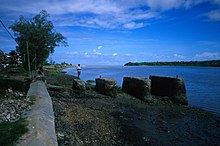Pangani (district)
| Pangani District | |
|---|---|
 Location of the Pangani district in Tanzania |
|
| Basic data | |
| Country | Tanzania |
| region | tanga |
| surface | 1831 km² |
| Residents | 54,025 (2012) |
| density | 30 inhabitants per km² |
| ISO 3166-2 | TZ-25 |
Coordinates: 5 ° 26 ' S , 38 ° 56' E
Pangani is a district in northeast Tanzania . It is located on the Indian Ocean in the Tanga region , the administrative center is the city of the same name Pangani . The district borders on the Muheza district to the north, the Indian Ocean to the east, the Pwani region to the south and the Handeni district to the west .
geography
The district has an area of 1831 square kilometers and around 54,000 inhabitants. The land rises gently from the Indian Ocean in the east to around 100 meters above sea level in the west. The drainage takes place via several streams and small rivers, all of which flow into the Indian Ocean. The largest river is the Pangani , which flows into the city of Pangani. The climate is tropical, Aw according to the effective climate classification . The precipitation of 1000 to 1500 millimeters per year falls in two rainy seasons. It rains most in the months of March to May, about a third falls in autumn from October to December. The average temperature is 27 degrees Celsius, the coolest is July with 24.8 degrees, the hottest in March with 29 degrees Celsius.
history
Remains of a small settlement from the 15th century have been found north of the city of Pangani. In the 19th century, the area was an important center for the slave trade under the rule of Zanzibar . The building for the district headquarters dates from the German colonial era .
Pangani was a separate division in 1922 and became part of Tanga in 1948.
Administrative division
The district is divided into thirteen parishes (wards) (as of 2012):
- Pangani Mashariki
- Pangani Magharibi
- Bweni
- Madanga
- Kimang'a
- Bushiri
- Mwera
- Tungamaa
- Kipumbwi
- Mikunguni
- Ubangaa
- Mkwaja
- Mkalamo
population
The population of Pangani rose from 37,670 in 1988 to 43,920 in the 2002 census and further to 54,025 in 2012. During these periods, the annual growth increased from 1.1 to 2.1 percent. In 2012, almost two-thirds of the over-five-year-olds spoke Swahili, 11 percent spoke Swahili and English, and 23 percent were illiterate.
Facilities and services
- Education: Around 10,000 students are taught by 229 teachers in 32 state and three private primary schools. The ten secondary schools are attended by 2,500 students (as of 2016).
- Health: There is a district hospital, two private hospitals, a medical center and 16 pharmacies for the medical care of the population. More than three quarters of households had health insurance in 2016 (members of the Communjty Health Fund).
- Water: In urban areas, 56 percent of households are connected to the water supply. Frequent failure of the pumps causes the supply to drop to around 45 percent. In rural areas around two thirds of the population have access to clean water within 400 meters of their place of residence.
Economy and Infrastructure
|
 |
politics
In Pangani, a district council is elected every five years. The council consists of eighteen members and is chaired by Said Ally Seifu (as of 2020) .
Attractions
- Saadani National Park: In the south, the district has a share of this 1062 square kilometer national park. It offers the opportunity to combine a beach holiday with wildlife viewing.
Web links
Individual evidence
- ↑ a b History | Pangani District Council. Retrieved July 22, 2020 (Swahili).
- ^ A b Tanzania Regional Profiles, 05 Tanga Regional Profile. (PDF) The United Republic of Tanzania, 2016, p. 15 , accessed on July 22, 2020 .
- ↑ Maps for the world, Map 500k - xb37-1, Map 500k - xb37-2. Retrieved July 22, 2020 (Russian).
- ↑ Climate Pangani: Climate table, weather & water temperature for Pangani - Climate-Data.org. Retrieved July 22, 2020 .
- ↑ nicole: History and more of Pangani and Ushongo Beach. In: Mike's Beach Cottages. January 1, 2020, accessed July 22, 2020 (American English).
- ^ Tanzania Regions. Statoids, June 30, 2015, accessed July 22, 2020 .
- ↑ 2012 Population and Housing Census. (PDF) National Bureau of Statistics and Ministry of Finance, March 2013, p. 999 , accessed on July 22, 2020 .
- ^ Tanzania Regional Profiles, 05 Tanga Regional Profiles. (PDF) The United Republic of Tanzania, 2016, p. 75 , accessed on July 22, 2020 .
- ↑ Elimu | Pangani District Council. Retrieved July 22, 2020 (Swahili).
- ↑ Takwimu | Statistics. Retrieved July 22, 2020 (English).
- ↑ Afya | Pangani District Council. Retrieved July 22, 2020 (Swahili).
- ↑ Maji | Pangani District Council. Retrieved July 22, 2020 (Swahili).
- ↑ Kilimo. Retrieved July 22, 2020 (Swahili).
- ^ Tanzania Regional Profiles, 05 Tanga Regional Profiles. (PDF) The United Republic of Tanzania, 2016, p. 136 , accessed on July 22, 2020 .
- ↑ Ufugaji. Retrieved July 22, 2020 (Swahili).
- ↑ Uvuvi. Retrieved July 22, 2020 (Swahili).
- ↑ Utalii. Retrieved July 22, 2020 (Swahili).
- ^ Trunk and Regional Roads Network. (PDF) March 2018, accessed on July 22, 2020 .
- ↑ Siegfried Schröder and Elke Kuhne: Elections in Tanzania 2015. (PDF) Rosa Luxemburg Foundation, November 9, 2015, p. 3 , accessed on July 22, 2020 .
- ↑ Madiwani | Pangani District Council. Retrieved July 22, 2020 .
- ↑ Mwanzo | Home. Retrieved July 22, 2020 (English).
- ↑ Tanzania in Figures 2018. (PDF) National Bureau of Statistics, June 2019, p. 8 , accessed on July 22, 2020 .
- ↑ Daniela Eiletz-chewing: Saadani National Park. In: Safari Insider. Retrieved on July 22, 2020 (German).

